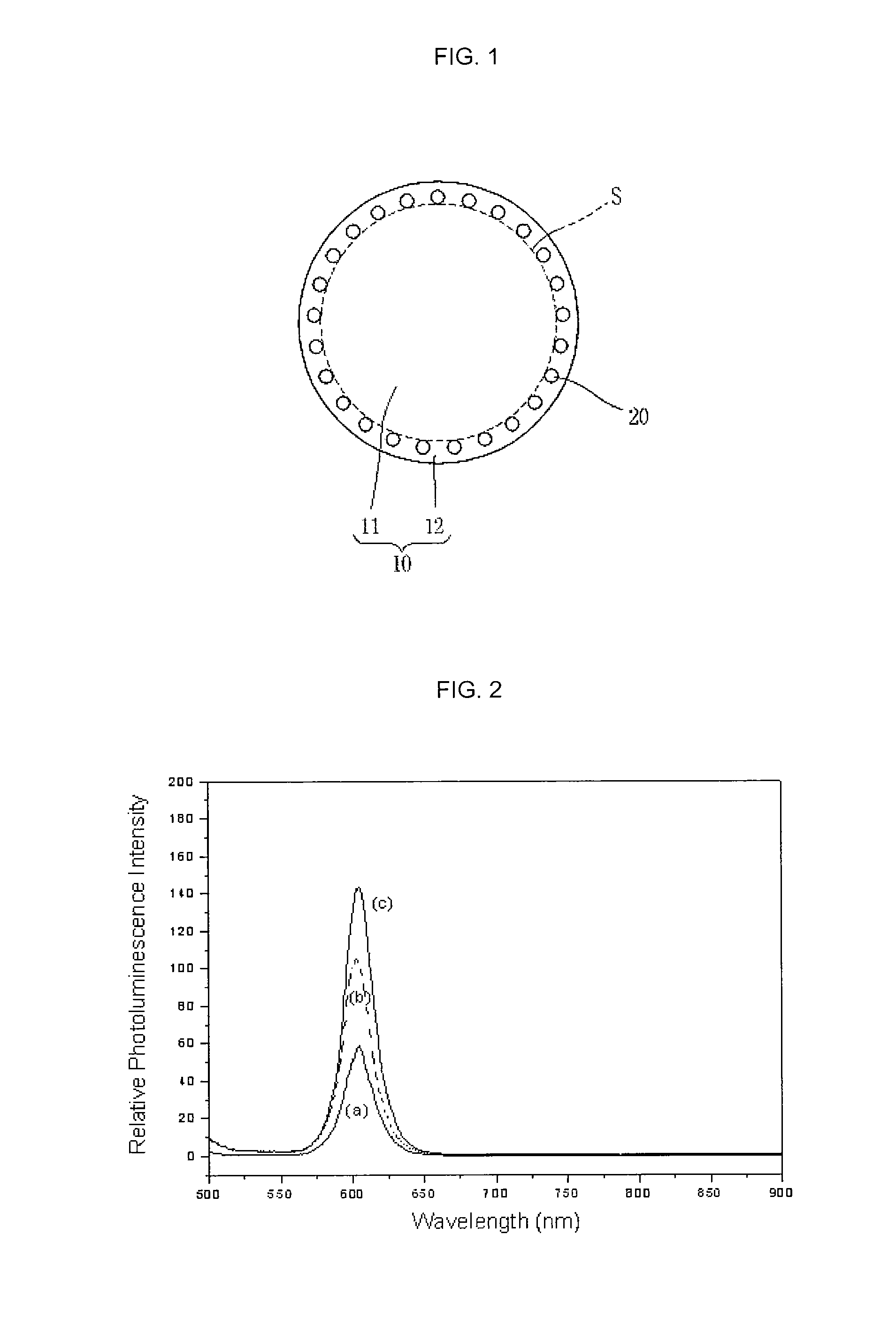Nanoparticle-doped porous bead and fabrication method thereof
a technology of porous beads and nanoparticles, which is applied in the direction of luminescent compositions, electrostatic spraying apparatus, bleaching apparatus, etc., can solve the problems of inability to uniformly dope the nanoparticle layer on the surface of the silica beads, the electrostatic force is too weak to achieve uniform doping of the nanoparticle layer, and the final fluorescence intensity is rather decreased, etc., to achieve enhanced fluorescence intensity, improved photo-stability, durability
- Summary
- Abstract
- Description
- Claims
- Application Information
AI Technical Summary
Benefits of technology
Problems solved by technology
Method used
Image
Examples
example 1
Fabrication of Silica Bead with Quantum Dot (Photoluminescent Nanoparticle) Layer Doped Therein
[0054](1) Fabrication of polyanionic monodispersed quantum dot CdSe / CdS(—SCH2CH2CO2−)ex aqueous solution
[0055]5 ml of quantum dot solution (2×10−5 M) in a core and shell structure (CdSe / CdS-ODA) with a surface protected by octadecylamine (ODA) was prepared and evaporates a hexane solvent therefrom by vacuum. The resultant solution was dispersed in 10 ml of chloroform, to which a methanol solution having 0.05 M mercaptopropionic acid (MPA) and 0.06 M sodium hydroxide melted therein, was then excessively added, thereafter being strongly stirred for 30 minutes. When 2 to 3 mL of distilled water was added to the stirred solution, quantum dots came up to a water layer, which was then separated. Methanol and ethylacetate were added into the separated water layer, thereby collecting the quantum dots by a centrifugal separation. Such quantum dots were dispersed in water and pH of the solution was ...
example 2
Fabrication of Silica Bead with Mixed Layer of Photoluminescent Nanoparticles and Another Nanoparticles Doped Therein
[0062](1) Fabrication of Polyanionic Monodispersed Iron Oxide Nanoparticle SPION (—O2CCH2CH2PO3−)ex aqueous solution
[0063]0.08 g of Trioctylammonium bromide was added to 10 mL of iron oxide nanoparticle (SPION-OA) solution having a surface protected by olein acid (OA) to be shaken for one day. To this solution was added 10 mL of solution containing 0.1 M carboxyethyl phosphonate, to thereby be shaken for another one day. When water and methanol were sequentially added to the resultant solution to be centrifugally separated, precipitates were generated. The precipitates were rinsed with ethanol and then centrifugally separated. Such precipitates were dispersed in water and pH of the solution was adjusted to approximately 10 by use of a diluted sodium hydroxide solution, thereby fabricating 190 mL (2×10−8 M) of polyanionic monodispersed nanoparticle (SPION(—O2CCH2CH2PO3...
PUM
| Property | Measurement | Unit |
|---|---|---|
| thickness | aaaaa | aaaaa |
| size | aaaaa | aaaaa |
| thickness | aaaaa | aaaaa |
Abstract
Description
Claims
Application Information
 Login to View More
Login to View More - R&D
- Intellectual Property
- Life Sciences
- Materials
- Tech Scout
- Unparalleled Data Quality
- Higher Quality Content
- 60% Fewer Hallucinations
Browse by: Latest US Patents, China's latest patents, Technical Efficacy Thesaurus, Application Domain, Technology Topic, Popular Technical Reports.
© 2025 PatSnap. All rights reserved.Legal|Privacy policy|Modern Slavery Act Transparency Statement|Sitemap|About US| Contact US: help@patsnap.com



